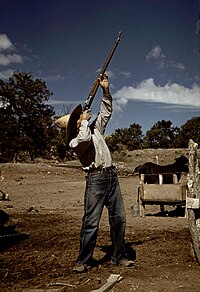Shooting
| This article does not cite any references or sources. (December 2006) |
Shooting is the act or process of firing rifles, shotguns or other projectile weapons such as bows or crossbows. Even the firing of artillery, rockets and missiles can be called shooting. A person who specializes in shooting is a marksman. Shooting can take place in a shooting range or in the field in hunting, in shooting sports or in combat.
Contents |
[edit] Technique and safety considerations
| This section requires expansion. (September 2008) |
| This section may contain original research. (September 2011) |
Shooting technique differs depending on factors like the type of firearm used (from a handgun to a sniper rifle), the distance to and nature of the target, the required precision and the available time. Breathing and position play an important role when handling a handgun or a rifle. Some shooting sports, such as IPSC shooting, make a sport of combat style shooting. The prone position, the kneeling position and the standing position offer different amounts of support for the shooter. Holding the gun sideways, as is sometimes seen in movies and on television, is poor gun handling; it makes the weapon likely to jam as any ejected case may fail to leave the weapon completely. There is an exception to this, however. "Bandit Shooting", so called because of its use with Chinese bandits of the early to mid 1900s, is where the gun (generally a handgun with a high rate of fire) is tilted on its side and aimed, the index finger is placed on the frame, and the trigger is pulled using the middle finger. It's used for "clean up" indoors or at very short range post-operation, as it is fairly inaccurate.
The utmost consideration for many shooters is gun safety. Like many activities such as mountain climbing, skiing, or sky-diving, there is an element of danger involved. And especially here, this danger demands a sober understanding and respect for firearms and the specific rules for the safe handling of them. This is compounded by the fact that the danger can easily extend beyond the participants—a stray bullet can injure or kill people other than those actually firing or handling the arms involved. At public ranges, the safety of all participants depends on the knowledge of everyone at the range.
[edit] Practical uses
| This section requires expansion. (September 2008) |
Shooting is used for hunting upland game birds such as grouse or pheasant, rabbits, culling, deer hunting or other wild game animals, or shooting pest animals. Sometimes "shooting" refers to the hunting activity itself.
Shooting is also used in warfare, self-defense, crime, and law enforcement. Duels were sometimes held using guns. Shooting without a target has applications such as celebratory gunfire, 21-gun salute or firing starting pistols, incapable of releasing bullets.
[edit] Entertainment shooting
Because shooting is an activity enjoyed not only by enthusiasts that do not own their own equipment or live in areas where firearms use is heavily regulated, an emerging solution is the entertainment shooting industry. For many years clay shooting with shotguns has been the primary entertainment shooting offering. Now, some shooting ranges in large cities rent guns to customers.
[edit] Competitive shooting
Marksmanship has inspired competition, and in several countries rifle clubs started to form in the 19th century. Soon international shooting events evolved, including shooting at the Summer Olympics (from 1896) and World Championships (from 1897). The International Shooting Sport Federation still administers Olympic and non-Olympic rifle, pistol, shotgun and running target shooting competitions, although there is also a large number of national and international shooting sports controlled by unrelated organizations.
[edit] Shooting supplies
Government legislation in most countries requires shooters to have some form of shooting licence, and firearms are typically only available from registered firearms dealers.
[edit] See also
| Wikimedia Commons has media related to: Shooting |

